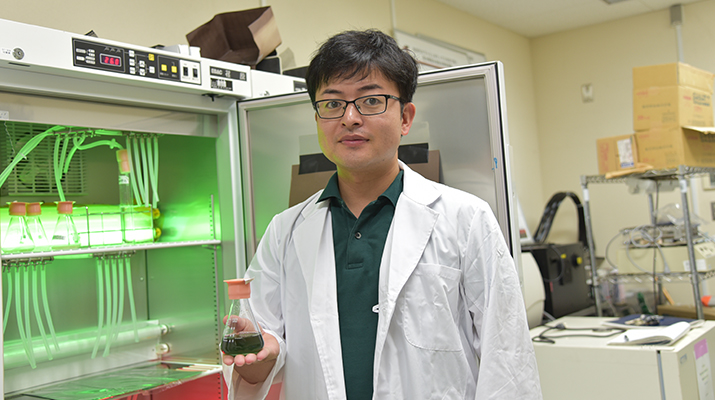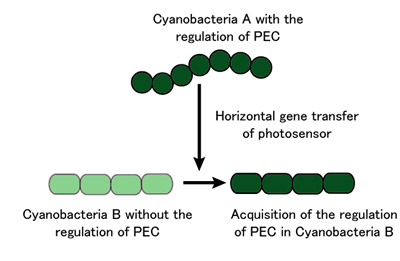
ここからコンテンツです。

Discovery of the Photosensor for Yellow-Green Light-Driven Photosynthesis in Cyanobacteria
By Yu Hirose
Cyanobacteria are a type of bacteria that performs photosynthesis, utilizing a photosensor to maximize their light-harvesting capacity under different light environments. A joint research team lead by Toyohashi University of Technology, in cooperation with the University of Tokyo and the National Institute for Physiological Science, has found a new photosensor that regulates yellow-green light-harvesting antenna in cyanobacteria. Further analysis of the cyanobacterial genomes revealed that this photosensor emerged about 2.1 billion years ago or more and evolved through genetic exchange between cyanobacteria.
Photosynthesis is a reaction that converts light energy into chemical energy. It is a fundamental reaction that supports all organisms living on the earth. Cyanobacteria are prokaryotes that perform oxygenic photosynthesis and are found in all kinds of environments throughout the world. Cyanobacteria have three types of major antenna proteins for harvesting lights: phycocyanin (PC) for absorbing red light, phycoerythrin (PE) for absorbing green light, and phycoerythrocyanin (PEC) for absorbing yellow-green light. To date, it has been known that the amount of PC and PE are regulated by a photosensor of the phytochrome-class, but no research has been reported on the regulation of PEC.

Assistant Professor Yu Hirose at the Department of Applied Chemistry and Life Sciences, Toyohashi University of Technology, in a joint research project with the University of Tokyo and the National Institute for Physiological Science, discovered a new photosensor regulating the amount of PEC. By searching through the genome database, the research team identified several cyanobacteria strains that harbors both PEC and the photosensor genes. Furthermore, they cultured one of the cyanobacteria strains and showed that the amount of PEC depends on the color of the light (Fig.1).

Further analysis of about 450 cyanobacteria genomes revealed that this photosensor regulating PEC emerged only once about 2.1 billion years ago or more and evolved through a genetic exchange between cyanobacteria strains (Fig. 2 and 3), which is a process called horizontal gene transfer. The photosensor was preferentially distributed among filamentous and multicellular strains but not unicellular strains. These cyanobacteria strains may utilize different light colors for photosynthesis between cells and share limited light energy.

PC and PE are currently used as natural food color additives in some foods. The result of this research can be applied to the mass production of PEC and the development of new food products. This finding may also be applied to the improvement of light energy conversion of photosynthesis and applied to research fields for the regulation of genetic functions using light illumination.
Reference
Hirose Y., Chihong S., Watanabe M., Yonekawa C., Murata K., Ikeuchi M., Eki T.
Diverse Chromatic Acclimation Processes Regulating Phycoerythrocyanin and Rod-Shaped
Phycobilisome in Cyanobacteria. Molecular Plant (2019) Feb 26. in press.
https://doi.org/10.1016/j.molp.2019.02.010
光合成に黄緑色光を使うための光スイッチを発見
By 広瀬 侑
光合成を行う細菌の一種であるシアノバクテリアは、緑色もしくは赤色の光を効率よく光合成に利用するための光スイッチを持っています。豊橋技術科学大学、東京大学、生理学研究所らの研究チームは、光合成に黄緑色光を利用するための新たな光スイッチを発見しました。さらに、ゲノム情報の解析により、この光スイッチが約21億年以前に誕生し、シアノバクテリア同士の遺伝子の交換によって進化してきたことを明らかにしました。
光合成とは、光エネルギーを化学エネルギーへと変換する反応であり、地球上の全ての生命の生存を支える重要な反応です。シアノバクテリアは酸素発生型の光合成を行う原核生物であり、世界中のあらゆる環境に生息しています。シアノバクテリアは光を集めるためのアンテナタンパク質として、赤色光を吸収するフィコシアニン、緑色光を吸収するフィコエリスリン、黄緑色光を吸収するフィコエリスロシアニン、の3種類を持つことが知られています。これまで、フィコシアニンとフィコエリスリンの量が光スイッチによって調節されることは知られていましたが、フィコエリスロシアニンの調節は報告例がありませんでした。
豊橋技術科学大学応用化学・生命工学系の広瀬侑助教らは、東京大学、生理学研究所との共同研究で、フィコエリスロシアニンを調節するタイプの光スイッチを発見しました。研究チームは、データベースに登録されたシアノバクテリアのゲノム情報を探索し、フィコエリスロシアニンと光スイッチを併せ持つシアノバクテリアの一群を特定しました。さらに、そのうちの1株を培養し、フィコエリスロシアニンの量が光の色によって大きく調節されることを実験的に証明しました(Fig.1)。さらに、約450株のシアノバクテリアのゲノム情報を詳細に解析したところ、このフィコエリスロシアニン調節型の光スイッチが約21億年以前にたった1度だけ誕生し(Fig.2)、その後、シアノバクテリア同士の遺伝子の交換(水平伝播)によって進化してきたことを明らかにしました(Fig.3)。また、光スイッチは、細胞同士が数珠のようにつながったシアノバクテリアに多く分布していました(Fig.3)。この理由としては、黄緑色光を吸収する量を調節することで、光合成に用いる光の色を細胞間で変え、光の奪い合いの競争を避けている可能性が考えられました。光スイッチは、限りある光エネルギーをシアノバクテリアが分かち合うために進化してきたのかもしれません。
フィコシアニンやフィコエリスリンは天然由来の色素としてアイスクリーム等の食品着色料として使用されています。本研究の成果は、フィコエリスロシアニンの大量生産やそれを用いた新たな食品開発への応用が期待できます。また、光合成の改変による光エネルギー変化効率の向上や、光照射によって生物の遺伝子の働きを制御する研究への応用が期待できます。
Researcher Profile

| Name | Yu Hirose |
|---|---|
| Affiliation | Department of Applied chemistry and Life Sciences |
| Title | Assistant Professor |
| Fields of Research | Genome Biology/ Photobiology |
ここでコンテンツ終わりです。
